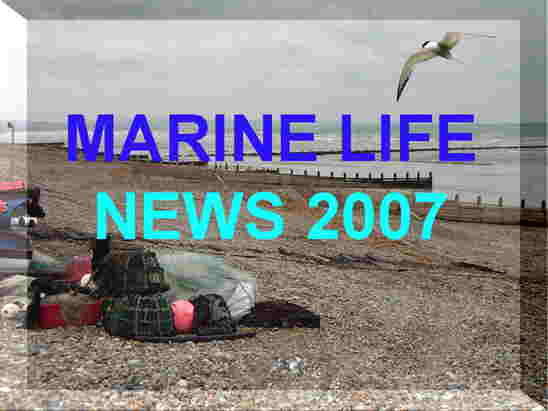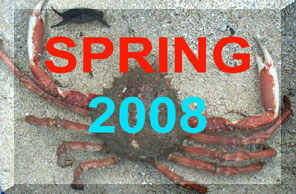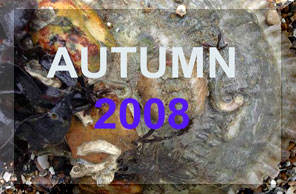EVENTS:
LATEST
NEWS:
18
December 2008
My
trawler caught a
Ray's Bream,
Brama
brama, at mouth of the River Thames.
It measured 50 cm (20 in) long and weighed 1.65 kg. This
fish was a new species for the River Thames.
Link
to the Photograph by Leon Roskilly
Many
more Ray's Bream Reports
11
October 2008
This
unusual fish was caught at Abbotsbury
on Chesil Beach, Dorset, on rod
and line with a Pouting
bait at 8.30 pm
by Kevin Hill from Crediton.

The yellow
mouth of this Bass-like fish rather gives away its identity as the rare
Meagre
Drumfish,
Argyrosomus
regius. It is so rare in British seas
that there are no angling records. It is a southern fish with a population
in the Mediterranean and adjacent seas. This is a juvenile as meagre
it is not and the name arose because of a transcription mistake in an old
book.
BMLSS
Drumfish
Early
September 2008
A
rare deep water Sowerby's Beaked Whale,
Mesoplodon
bidens, was washed up dead at Periglis
in the west of the island of St. Agnes in the Isles of Scilly , west of
Cornwall.
Just
400 meters away on the same beach, an infant Risso’s
Dolphin, Grampus
griseus, was also discovered.
BMLSS
Cetaceans
3 July
2008

Broad-billed
Swordfish
Photograph
by Colin Smith
(Amgueddfa
Cymru - National Museum Wales)
A Broad-billed
Swordfish,
Xiphias
gladius,was
discovered washed up dead on Barry
Island beach, Vale of Glamorgan, South Wales. It was carefully
examined by Dr Peter Howlett, (Curator of
Lower Vertebrates, National Museum, Wales)
who confirmed the identification and found it to be a young specimen 2.24
metres long and between 60 and 80 kg in weight. It had been dead
only a few days, but it had been scavenged by other creatures and it was
not possible to determine the cause of its death.
Full
Report
BMLSS
Swordfish Reports
1 July
2008
WARNING
I
was badly stung by a Snakelocks Anemone,
Anemonia
viridis, whilst swimming in an intertidal
bathing pool at Dancing
Ledge, Purbeck, Dorset.
Full
Report
Stings
from Snakelocks Anemones
29
June 2008
A
huge Edible Crab,
Cancer
pagurus, was discovered and brought
ashore by Paul Worsley
diving in Lyme Bay,
Dorset. It was estimated to be 300 mm wide across the carapace and a crab
of this size would be the largest on record. (The
largest recorded specimen known was 285 mm wide.) Its huge size can be
verified by the photograph in the Western
Morning News but unfortunately the crab was eaten before a tape measure
could put on the shell and photographed to verify the crab as the largest
on record.
26
June 2008
A
huge Edible Crab,
Cancer
pagurus, was captured and brought
to the surface from a plastic barrel on the seafloor at Balaclava
Bay off Portland, Dorset. The male crab was not measured but estimated
to be about 30 cm wide across the carapace. It was found a home in Weymouth
Sea Life Centre. Both its massive claws were intact and bigger than
my hands.
Capture
and Report by Paul Martin
with
the help of companion diver Mary Harris
Dorset
Echo Report
BMLSS
Edible Crab
14
June 2008

Venue:
Coronation
Green, Shoreham-by-Sea
Admission:
FREE
Adur was
one of the UK leaders in presenting an environmental exhibition of World
Oceans Day on Coronation
Green, Shoreham-by-Sea,
as part of the Adur
Festival.
9
June 2008
At
least 26 Common Dolphins, Delphinus
delphis, died after becoming stranded
in Porth
Creek up the Percuil
River, Cornwall. (The Percuil River meets
the Carrick
Roads sea inlet near Falmouth.) These
were just a small group of many more dolphins
in the Carrick Roads around Falmouth.
Whales
& Dolphins in British Seas (Link)
BMLSS
Cetacea
5
June 2008
In
the early hours a large Stingray,
Dasyatis
pastinaca, was caught by an angler
Ken
Canning off the beach at Pagham
Harbour, Sussex, and released back alive. It weighed between 65 lb
and 72 lb; this should be a BR
(R-C) FC record.
“This
magnificent fish which was probably around 72 lb as that’s what
it weighed first time but it slipped of the sheet. When weighed second
time it was still touching the floor but we were concerned with the health
of the fish so settled on 65 lb 2 oz then returned it.”
British
Shore Caught Angling Records
3 March
- May 2008 onwards
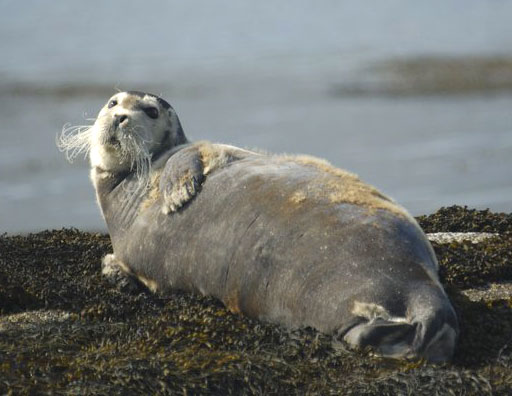
A
Bearded
Seal, Erignathus
barbatus, was spotted at Loch
na Keal on the Isle of Mull,
a large island
in the Inner Hebrides, western Scotland. The healthy seal
had hauled itself up on to some dry rocks when it was first seen. Subsequently,
it has been unpredictable in its movements. The Bearded
Seal was first seen by David
Woodhouse (Mull Wildlife Expeditions)
on
3
March 2008.
May
2008
A
surprising capture of a Pacific Humpback
Salmon,Oncorhynchus gorbuscha, specimen
caught by Louis Hunter
in the River
Tweed near Berwick-upon-Tweed
on the English-Scottish border, is the first to be caught in a British
river by rod and line, weighed, verified, and submitted to the British
Records Fish Committee (BRFC). The committee has recorded it as a new
species on its game list. The fish weighed 1.6 kg.
Its
origins are likely to be the Barents
Sea, where the Russians introduced thousands of Humpback
Salmon 40 years ago as part of a large breeding
programme.
Over
the last 10 years some of these have successfully bred in rivers in Norway
and Iceland. It appears they have begun to cross the North Sea to Britain,
although there is no evidence yet to suggest they are breeding here. There
has been anecdotal evidence of fishermen accidentally snaring them in trawler
nets off the east coast.
11
May 2008
A
female Deep-water Red Crab,
Chaceon
(=Geryon)
affinis,
was
captured in deep water (300 metres) off the west off the Orkney
Isles, north of Scotland. It survived a number of days in a boats vivier
tank before being transferred to an aquarium.

The
Orkney fishermen call them "Red Crab"
but they are not common.
Full
Report
More
Information
ID
by Richard Lord (Guernsey)
Sealord
Photography
8 -9
May 2008
Guernsey
recreational fisherman Andy Marquis
discovered the pulmonate Celtic Sea Slug,
Onchidella
celtica, at St.
Martins Point, Guernsey. (I have been
looking for them for a decade without success!)
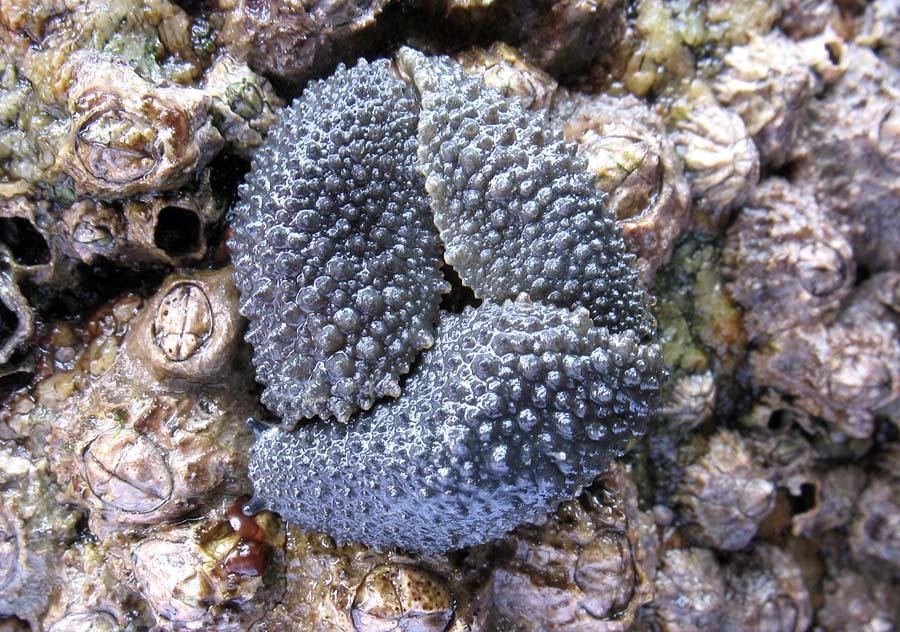
The
following day my wife and I found 278 individuals in the Fucus
spiralis zone on the vertical face of
a rocky outcrop.
Full
Report
Sealord
Photography
3 March
2008
A hexapus,
or six-legged version of the Lesser or
Curled Octopus,
Eledone
cirrhosa, was captured in a lobster pot
off the coast of north Wales and put on show at the Anglesey
Sea Zoo. It was only then it was discovered to
have only six legs instead of the normal eight, and this may have a result
of a birth defect rather than an accident. It was been claimed as a world's
first as nobody seems to discovered one before. Its fame meant it was transferred
to the Blackpool
Sea Life Centre to attract a bigger audience.
BMLSS
Octopuses
28
January 2008
Guernsey
commercial fisherman Rick Ferbrache
brought me a Red Sea Bream (=Blackspot
Sea Bream), Pagellus
bogaraveo, caught off Portinfer Bay
on the north-west coast of Guernsey. It weighed 454 grams and was
32.6 cm long (total length).

Red
Sea Bream were
common in Guernsey waters until 1984 and then they disappeared. During
the last year or so they have been making a comeback to Guernsey waters.
Sealord
Photography
BMLSS
Sea Breams
21
January 2008
Timber
from Greek-registered Ice Prince,
which sank about 26 miles (42 km) off Dorset after a storm on 15
January 2008, began getting washed up on Lancing
beach in the evening of 19 January 2008
and
and tonnes of pine planks littered the
Sussex
beaches from 20 January 2008. The
usual debris was on the
strandline including
the eggcase of an Undulate Ray,
Raja
undulata. It measured 67 mm long and 48
mm wide.
BMLSS
Eggcases
Adur
Coastal 2008
Dates
Information by Jason Koen
3 January
2008
A
rare Kemp's Ridley Turtle, Lepidochelys
kempii, was washed up at Porth
Ceiriad on the Llyn
peninsula, north-west Wales.
Kemp's
Ridley Turtles are
listed as critically endangered by the World
Conservation Union, with only 35 records
of the Kemp's Ridley species in UK and Irish waters. According to the Marine
Conservation Society the latest estimates suggest that only a few thousand
adult females still nest on only one stretch of beach on the coast of the
Gulf of Mexico.
BMLSS
Turtles
A
Grey
Seal, Halichoerus grypus,
was washed up dead on the shore at Sheringham
in Norfolk with a large 35 cm wound reminiscent of a predator attack. The
jury is out on the cause of the wound which could be as a result of fishing
activity.
Discussion
on the Marine Wildlife
of the NE Atlantic Yahoo Group
The
previous week in Kent we had a dead seal
turn up with large wounds on it. They were circular and about 50 mm in
diameter.
BMLSS
Seals
British
Marine Life News 2007

Cornish
Marine Life Records 2006
BMLSS
Oil Disasters page


